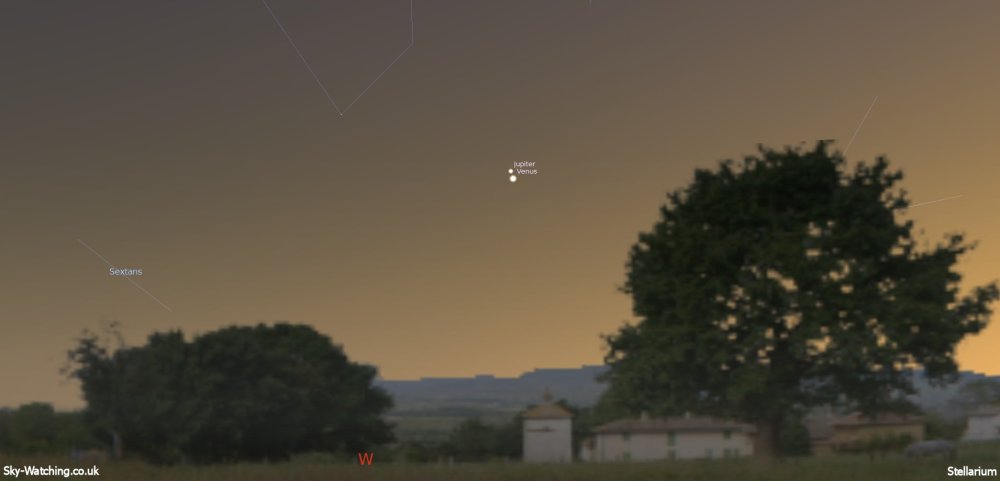by yaska77
It would seem that the UK’s infamous “April Showers” were a little tardy this year, eventually turning up fashionably late in May… Clear evenings were sadly few and far between which meant any serious observing was very difficult to arrange! But weather forecasters are hopeful for June, and we’ll take any piece of positivity we can get at the moment!
Although we have fewer hours of darkness as summer approaches the warmer evenings certainly make stargazing more enjoyable, so take a gander at the list of heavenly happenings coming up this month (as outlined below) and get outside and enjoy the evening!
I can feel a Sky-Watching BBQ coming on 🙂
Keep watching those skies…
Tuesday 2nd June – The Full Moon today is sometimes known as the Rose Moon, Lotus Moon or Planting Moon
Saturday 6th June – Evening star Venus is at Greatest Eastern Elongation today, and appears as the brightest light in the western sky after sunset
Tuesday 9th June – This evening our Moon will be seen at Last Quarter phase
Wednesday 10th June – Today the Moon is at Perigee (the closest point of its orbit to the Earth) at a distance of 369,710 km (229,727 miles)
Sunday 14th June – Messier 57 in the constellation Lyra is almost directly overhead at 01:00 UTC (02:00 BST) this morning. Also known as the Ring Nebula, we managed to get a faint image of this outstanding nebula in 2011 so would love to get another clear evening to give it the stacked image treatment!
And with the Moon more or less out of the way conditions (weather withstanding) couldn’t be better!

Also today, Mars is in conjunction with the Sun so is currently unobservable
Tuesday 16th June – Today the New Moon rises and sets with the Sun, so now is a good time to observe deep sky objects like galaxies and nebulae
And to help identify the constellations you can see throughout the month, below we’ve provided guide images for both southern and northern skies in June


Saturday 20th June – If you’re a bit of a shutterbug there’s a good opportunity for some nice photography tonight, when the thin crescent Moon forms a triangle with Jupiter and Venus after sunset this evening
Shown below to the west at 21:00 UTC (22:00 BST), if your horizon is flat enough this group of bright celestial objects could provide some nice images as the twilight skies darken

Sunday 21st June – Today it is Summer Solstice in the Northern Hemisphere
Tuesday 23rd June – The Moon is at Apogee today at a distance of 404,130 km (251,115 miles), the furthest point its orbit will take it away from the Earth this month
Wednesday 24th June – Today the Moon is at First Quarter phase, and Mercury is at Greatest Western Elongation but remains lost in glare from the Sun
Sunday 28th June – Remember that now is a great time of year to look for noctilucent clouds, which sometimes appear low down in the northwest (after sunset) and northeast (just before sunrise)

These clouds are in the upper atmosphere and are usually too faint to see, becoming visible only when illuminated by sunlight from below the horizon while the lower layers of the atmosphere are in the Earth’s shadow
Tuesday 30th June – Bright gas giant Jupiter and evening star Venus finally meet in the sky this evening (closest as they set around 22:00 UTC (23:00 BST)

Shown above at 20:45 UTC (21:45 BST) low to the west, Venus has been slowly creeping towards Jupiter throughout June but tonight they will appear just 20 arcminutes apart! To give you some scale, a Full Moon is about 30 arcminutes across, so both will be nicely in frame through a scope or binoculars
It’s not too often you get the chance to observe two planets in the same magnified field of view! A great target for some scope photography I think, so let’s hope for clear skies 🙂
As usual, if you take any photos throughout June you’d like to show us, please tweet them to us using the link below! We’d love to see your efforts and we’ll re-tweet them to your fellow sky-watchers!
Planets visible this month:
Jupiter
Mercury
Saturn
Venus
Neptune
Remember, it can take your eyes up to 20 minutes to become properly dark adapted, and anything up to an hour for a telescope to reach ambient temperature outside (to ensure the best image), so give yourself plenty of time to get set up!
To make it easier to find this list of astronomical happenings you can also locate it in the “Monthly Guide” section in the menu bar to the right. Handy! 🙂
Guide images created with Stellarium
Archive:
Astronomy Events – May 2015
Astronomy Events – April 2015
Astronomy Events – March 2015
Many many thanks 😀 Just in time to start watching moon tomorrow 😀
LikeLike